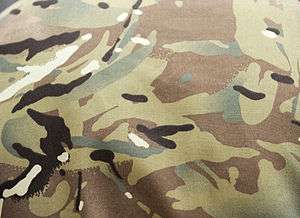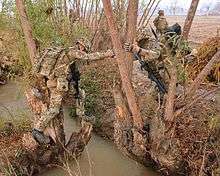Multi-Terrain Pattern
| Multi-Terrain Pattern | |
|---|---|
 Multi-Terrain Pattern fabric | |
| Type | Military camouflage pattern |
| Place of origin | United Kingdom |
| Service history | |
| In service | March 2010 - Present |
| Used by | See Users |
| Wars |
War in Afghanistan Iraq War |
| Production history | |
| Designer | Defence Science and Technology Laboratory |
| Designed | 2002 |
| Manufacturer | Crye Precision |
| Produced | 2010-Present |
The Multi-Terrain Pattern (MTP) is a camouflage pattern printed on equipment issued to British forces.
As part of the British Ministry of Defence's (MOD) Personal Equipment and Common Operational Clothing (PECOC) programme, three new camouflage patterns were considered for issue to British forces. These were a revised temperate DPM using lighter colours, a new three-colour desert pattern with enhanced utility for night-time operations, and a hybrid four colour scheme using two colours from each of the previous patterns for use on webbing in all terrains.
History
Following an Urgent Operational Requirement for a camouflage uniform for the Afghan theatre of operations, and the success of a commercially available pattern (Crye's MultiCam) when tested in trials, a decision was made to use MultiCam as the basis of a new Multi-Terrain Pattern for British armed forces, replacing the previous temperate DPM uniforms. Desert DPM uniforms were to be retained but later entirely replaced alongside Woodland DPM.
The United Kingdom's Ministry of Defence announced that HM Forces would be issued with the new British Army uniform for operations in Afghanistan; initially issued to personnel deployed on Operation Herrick from March 2010, then issued more widely to HM Forces from 2011 onward replacing all DPM including Woodland and Desert variants of the Combat Soldier 95 uniform by 2013 alongside with the introduction of the new Personal Clothing System.[1]
Development

The MTP camouflage design was intended to perform consistently across a wide range of environments encountered, particularly for operations that the military had been deployed during 2009.
British Troops in Afghanistan operate in a mixed landscape, including desert, woodland, mountains and urban. The development team at the Defence Science and Technology Laboratory tested various camouflage variations against the standard army disruptive pattern materia and the desert DPM to determine the best balance of colours. The current HM Armed Forces camouflage were then tested alongside off-the-shelf multi-terrain camouflage. The tests were against terrain that soldiers are likely to encounter across the landscape in Afghanistan.[2]
A wide range of camouflage colours were trialled in Britain, Cyprus, Kenya and Afghanistan.[3] Camouflage patterns were compared with in-service and commercially available patterns—including those from Crye Precision in the United States. The trials included visual comparisons, objective assessments of the time to detect the different camouflage patterns against different backgrounds, and subjective user opinions on the efficacy of the performance.
Crye's "Multicam" pattern was determined to be the best performing, across the widest range of environments (by a significant margin) and was subsequently selected as the basis for the new British MTP camouflage, and combined with the shapes of the existing British DPM pattern. The MTP pattern itself was not trialled against other patterns and its adoption was based solely on its similarity to the original Crye Multicam pattern.[4][5]
Users



References
- ↑ "Introduction of Personal Clothing System - Soldier Systems Daily".
- ↑ Defence Science and Technology Laboratory (2009-12-20). "Testing the new Multi-Terrain Camouflage" (PDF). Press Release (Press release). Ministry of Defence. Archived from the original (PDF) on 2011-04-05. Retrieved 2009-12-21.
- ↑ "New Afghanistan camouflage design unveiled". MoD Defence News Online. 2009-12-21. Archived from the original on 2012-10-26. Retrieved 2009-12-21.
- ↑ Emery, Daniel (2009-12-20). "British Army to get new camouflage uniform". BBC News Online. Retrieved 2009-12-20.
- ↑ Copping, Jasper (2009-12-20). "British Army to get new uniforms – turned down by the US and made in China". The Daily Telegraph. London. Retrieved 2009-12-20.
- ↑ "New Combat Uniform for Armed Forces of Malta. - Combat & Survival". 1 August 2014.
- ↑ https://www.telegraph.co.uk/news/newstopics/onthefrontline/6844734/British-Army-to-get-new-uniforms-turned-down-by-the-US-and-made-in-China.html
- ↑ http://www.royalgazette.com/article/20120113/NEWS/120119995
- ↑ Joshua Saunders (18 June 2014). "For Queen and Country - The Falkland Islands Defence Force (FITV)" – via YouTube.
- British Army (2009-12-16), Defence Internal Brief, Ministry of Defence (2009DIB/52) Missing or empty
|title=(help) - "British Army to get new uniform camouflage design" (Video). BBC News Online. 2009-12-20. Retrieved 2009-12-21.
- Sengupta, Kim (2009-12-21). "Army unveils a uniform for the Afghan landscape". Independent. London. Retrieved 2009-12-20.
- "British troops to get first new camouflage in 40 years". CNN. 2009-12-20. Retrieved 2009-12-21.
External links
| Wikimedia Commons has media related to Multi-Terrain Pattern. |
- United States patent, number US D659,406 S for Multi-Terrain Pattern
- Official Cyre Precision website
.jpg)